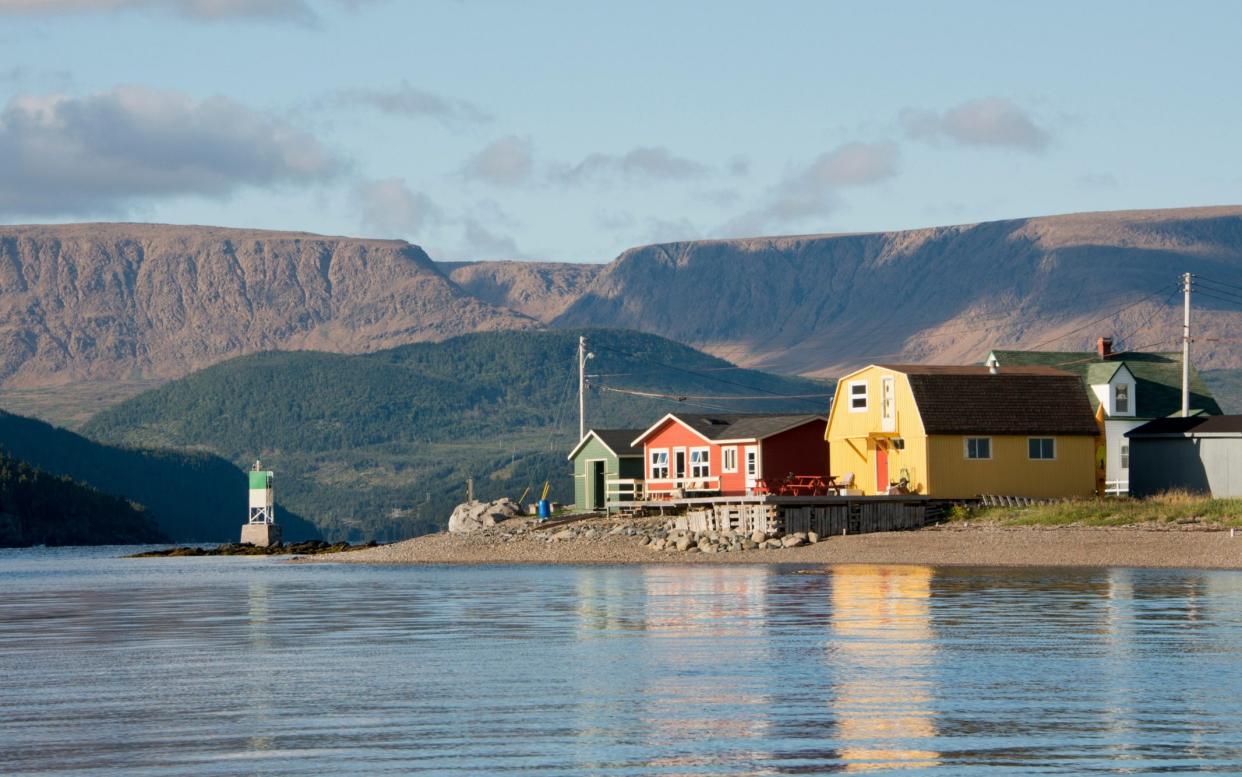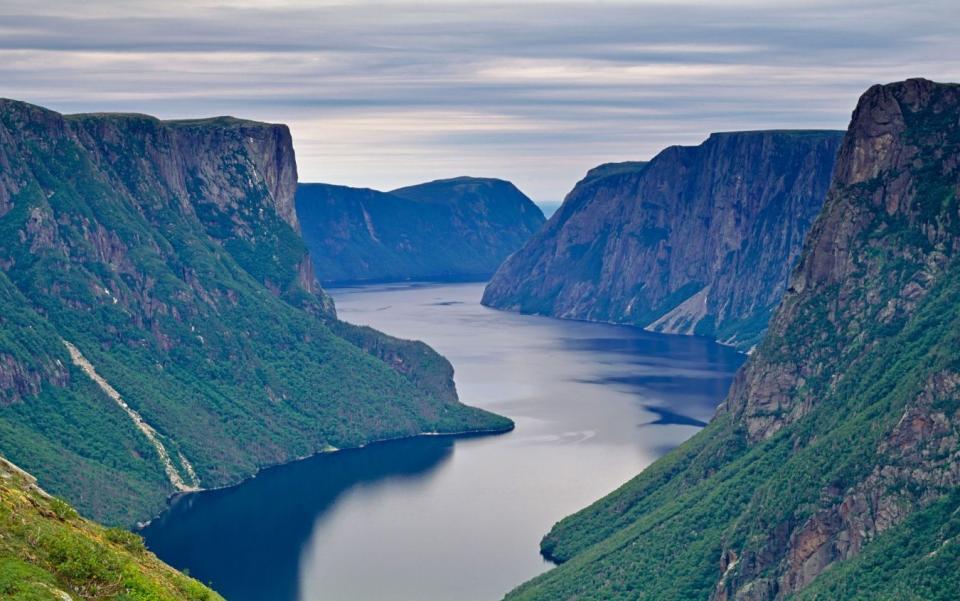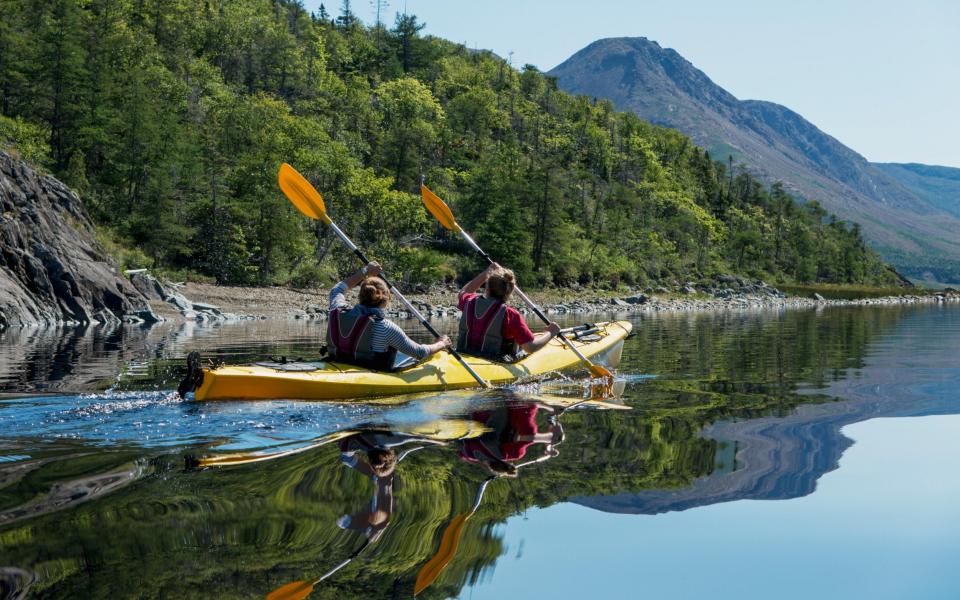The Canadian province that has discovered the meaning of life

As I crested the rise, the clouds parted – just enough. Enough that I was unexpectedly smacked by the planet’s innards. On the road ahead, conjured from the mists, sat an immense, incongruous sucker-punch of rusted rock; a tangerine freak in the boreal green. I reflexively pressed the brakes; swore out loud. The wrong shape, the wrong colour, the wrong world, this glacier-cut lump – known as the Tablelands – seemed to have no earthly right to be here. Though Earth it was, in its purest, rawest form.
Gros Morne doesn’t play by the rules; it rewrites them. This area of Newfoundland’s west coast has been called the greatest textbook, geologically speaking. Thanks to its groundbreaking rocks, and generally knock-out scenery, Gros Morne was designated a national park in 1973, 50 years ago. It is now a Unesco World Heritage site too.
“This place changed the way we understand the world,” explained ranger Josh Penney as he led a free public walk into the surreal Tablelands landscape. In the 1970s this was a proving ground for the then-new and controversial theory of plate tectonics, because it’s one of the few places on the planet where the Earth’s mantle is exposed, in large quantities, in perfect, unmetamorphosed form. “There are a few other bits elsewhere,” Josh admitted, “but we have a parking lot and the best guides.”
It’s certainly worth seeing with a guide; someone who can interpret this eerie, Martian place, where the volcanic peridotite has oxidised to burnt orange and is so toxic to plants that only the pluckiest survive, some ghoulishly carnivorous. Someone who can explain how it was birthed 500 million years ago by the collision of ancient continents, and was left exposed as those continents split again, creating the Atlantic Ocean.

Key to the discovery of all this was Newfoundland geologist Harold “Hank” Williams, who formulated his notions in Gros Morne in the 1960s and 1970s. Hank had many passions; not only rocks but map-making, storytelling, the occasional dark rum, local music – he could play many instruments. He likened his plate tectonics idea to the pulling and pushing of an accordion’s squeeze box, christening it the Harry Hibbs Effect after Newfoundland’s legendary accordionist. When Hank gave talks on tectonics, he’d often finish with a few tunes.
Which seems fitting. Because in Newfoundland, music – and the sense of place and community that comes with it – is as foundational as the rocks. And might go some way to explaining why, despite experiencing some of the country’s wettest, windiest, foggiest weather, the province reports the highest levels of life satisfaction in Canada. As I explored Gros Morne in the west and St John’s in the east, from billion-year-old mountain to intimate singalong, I figured Newfoundlanders might have things sussed.

From Tablelands I spent a few days driving northwards through the national park, CBC news keeping me informed: a head-on moose crash, turmoil at the snow crab fishery, a food bank receiving its first donation of cod. First, I stopped at Woody Point, on beautiful Bonne Bay. Indigenous people have lived on Newfoundland for over 10,000 years but Woody Point was officially established by traders from Dorset in around 1800. Now it’s a quiet cluster of bright-painted heritage buildings. I called in at one, the Merchant Warehouse café, where sea shanties drifted from inside as I ate shrimp out on the deck, watching the ripples, looking up to the surrounding hills.
Norris Point was only a mile across the water, as the bald eagle flies. But it took an hour – and a few geological eons – to drive there, around Bonne Bay’s South and East Arms. At Norris I slid into a kayak with Gros Morne Adventures, in an attempt to take it all in. Out on the glassy blue, every which way was different. Tablelands squatted to one side; the baldpate of Gros Morne Mountain, created from ancient seaside sand, was on the other.
We paddled to Shag Cliff, its tilted limestone providing welcome shade. And we crossed the deep channel of the Tickle – “there was a whale here yesterday,” guide Emily said – to reach the empty, grassy slopes of Gadd’s Harbour. A village stood here once, the kids travelling to school by boat or ice bridge; but, like many of Newfoundland’s small, impractical outports, it was abandoned decades ago.

The highlight of Gros Morne is Western Brook Pond, a deep lake framed by towering gneiss and granite that, dating back 1.25 billion years, is twice as old as any other rock in the park. I made the easy two-mile walk, via cotton grass, black pine and bog, to reach the tour boat jetty. Sailing in between its 2,000ft-high walls, it felt right out of Norway; a landlocked “fjord” of Asgardian epic-ness. I expected to see gods carved into the sides – and the captain did point out phantom “faces” in the fissures, hanging valleys and waterfalls. On the return, the commentary stopped, and we cruised in private awe, to a CD of Newfoundland tunes.
That was fine, but not a patch on the real thing, which I got to hear later. The Gros Morne Theatre Festival is held annually, June to mid-September, at the Cow Head arts centre, in the park’s far north. Performing that night was Daniel Payne, a man passionate about researching, adding to and sharing Newfoundland’s great musical canon. With his red beard tickling his fiddle, Payne and two fellow musicians jammed through songs about shipwrecks and lumber, unlucky courtship and grey foggy days; tunes apt to bring a tear to every Newfoundlander’s eye. I might hail from 4,000 miles away, but I was tapping my toes with the rest.
“I still sell a lot of CDs,” music shop owner Dave Rowe told me a few days later, with a mystified grin. “People want to take home a bit of what they’ve heard, even if they don’t have CD players.”
I’d flown from Gros Morne to St John’s, and was browsing the harmonicas, banjos, accordions and ugly sticks at O’Brien’s Music, a local institution. Dave’s grandfather, Roy O’Brien, founded the place in 1939, at the unlikely age of 16; musician Dave took it on in 2015. “It’s changed over time,” he said, “but I try to keep it true to its original character.”

Dave recommends a few bars in the city: The Ship, Erin’s Pub. “The music scene here is small but potent,” he explained. “Even in the doldrums of winter you can find high-level live music seven nights a week.”
Fortunately for me, it was high summer. The sun was glaring off St John’s multi-coloured “jellybean” houses and glittering in the Atlantic waters, which squeeze through the Narrows into the tightest of harbours. It was good weather for exploring so, with guide Andrew, I headed off on a road trip along the wiggly, fingery, puffin-flocked coast south of the city, known as the Irish Loop.
We paused first at Cape Spear, just outside St John’s. It was crowded, but essential tourist viewing. Here, standing on an unfenced cliff-top dirt-patch near the 1830s lighthouse, I was briefly the easternmost person in North America. Then we continued, making it as far south as Ferryland. Founded by the British in 1621, it’s one of the oldest colonial settlements in Newfoundland, and was one of the most important fishing ports. These days it certainly isn’t. It’s a quiet spot where you can see archaeologists digging over the remnants of 17th-century homes before walking out to the old lighthouse for a picnic. As I drank my homemade lemonade, I watched three whales flicking and blowing offshore.

Ferryland has a long music tradition, and was home to local legend Ron Hynes, known as the “man of a thousand songs”. A new memorial to him sits by the shore. But for my farewell do, I was off to Sullivan’s Songhouse.
Sean Sullivan inherited the house overlooking Calvert Bay, an hour south of St John’s, when his mother died. And he now opens it up for kitchen parties, a version of the traditional carousing sessions that often kicked off around the wood stove in the area’s Irish-heritage communities. I thought Sullivan’s might be twee and touristy. And, yes, there were holidaymakers from New York and Tennessee. But there was also a lady from nearby Trepassey, even one from Calvert itself. Newfoundlanders and “come-from-aways” come together for the simple pleasure of a sing-song.
Sean was on guitar, his friend Sheldon on accordion; they shared the storytelling in between. It was impossible not to grin and tap and clap along; by the second chorus of every tune, we’d all got the gist and were belting out lyrics like we’d known them since childhood. The sort of songs that feel like they’ll remain forever embedded in Newfoundland’s soil, soul and saltwater, no matter how the plates shift.
Essentials
Audley (01993 460533; audleytravel.com) offers tailor-made trips to Newfoundland and Labrador; a sample 15-day self-drive, via Gros Morne and St John’s, costs from £2,855pp including accommodation, car hire and flights. Air Canada (0800 756 3865; aircanada.com) flies to St John’s via Halifax or Toronto; returns from around £640.
Where to stay
Neddies Harbour Inn (001 877 458 2929; theinn.ca) is a lovely hotel on Bonne Bay with an excellent restaurant; doubles from £125. The Shallow Bay Motel (001 800 563 1946; shallowbaymotel.com) is a friendly ocean-side stop in Cow Head; doubles from £82. The DoubleTree St John’s (001 709 383 1475; hilton.com) is right on the harbour; doubles from £58.
Things to do
Two-hour kayak tours on Bonne Bay from £32pp (grosmorneadventures.com). Western Brook Pond boat tour £42pp (bontours.ca). Sullivan’s Songhouse £17.50pp (sullivanssonghouse.com); open Wednesdays and Saturdays, June-October.
More info
Visit: explore-canada.co.uk; newfoundlandlabrador.com; legendarycoasts.ca; gowesternnewfoundland.com


